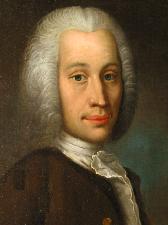
Anders Celsius
1701-1744
Anders Celsius, born in Uppsala, was one of a large number of scientists (all related) originating from Ovanåker in the province of Hälsingland. The family name is a latinised version of the name of the vicarage (Högen). His grandfathers were both professors in Uppsala: Magnus Celsius the mathematician and Anders Spole the astronomer. His father, Nils Celsius, was also professor in astronomy. Celsius, who was said to have been very talented in mathematics from an early age, was appointed professor of astronomy in 1730.
He began his "grand tour", lasting for four years, in 1732, and he visited during these years almost all the notable european observatories of the day, where he worked with many of the leading 18th century astronomers.
Soon after his return to Uppsala he participated in the French astronomer Maupertuis' famous expedition 1736 to Torneå, in the most northern part of Sweden. ("The Lapland expedition.") The aim of the expedition was to measure the length of a degree along a meridian, close to the pole, and compare the result with a similar expedition to Peru (today Ecuador) near the equator. The expeditons confirmed Newton's belief that the shape of the earth is an ellipsoid flattened at the poles.
Celsius' participation in this expedition made him famous and was important in his efforts to interest the Swedish authorities in donating the resources necessary to build a modern observatory in Uppsala. He was successful, and the Celsius observatory was ready in 1741, equipped with instruments purchased during his long voyage abroad, comprising the most modern instrumental technology at that time.
In those days geographical measurements, metereological observations and other things, not considered as astronomy today, were included in the work of an astronomy professor. He carried out many geographical measurements for the Swedish General map, and was also one of the first to note that the land of the nordic countries is slowly rising above sea level, a process which has been going on since the melting of the ice from the latest ice age. He believed though, that it was the water that was evaporating.
For his metereological observations he constructed his world famous Celsius thermometer, with 0 for the boiling point of water and 100 for the freezing point. After his death in 1744 the scale was reversed to its present form.
Together with his assistant Olof Hjorter he also was the first to realize that the aurora phenomenon has magnetic causes through observing the inclination of a compass-needle and finding that the larger deviations correlated with stronger aurora activity.
In astronomy he made observations of eclipses and various astronomical objects. He published catalogues of carefully determined magnitudes for a total of 300 stars using his own photometric system (mean error=0.4 mag). The idea of his system consists of using identical transparent glass plates and viewing the ray of light from a star through them. He could then compare the magnitudes of the stars by the number of glass plates needed to extinguishe the light. (The star Sirius, the brightest star in the sky, needed 25 of his plates to be extinguished.)
Celsius published most of his work in the publications of the Royal Society of Sciences in Uppsala, which is the oldest Swedish scientific society founded in 1710, where Celsius was the secretary 1725-1744, and in the publications of the Royal Swedish Academy of Sciences, founded in 1739. He also presided at about twenty dissertations in astronomy where, as was the general rule in those days, he was the main author. His popular book Arithmetics for the Swedish Youth was typical of the spirit of his period, the Enlightenment.
Celsius was a very active supporter for introducing the Gregorian calender in Sweden but he wasn't successful until 1753, almost ten years after his death, when the Julian calender was abandoned by dropping 11 days.
Anders Celsius died of tuberculosis in april 1744, only 42 years old. His grave is next to his grandfather's, Magnus Celsius, in the church at Gamla Uppsala, about 5 km north of central Uppsala.
No comments:
Post a Comment